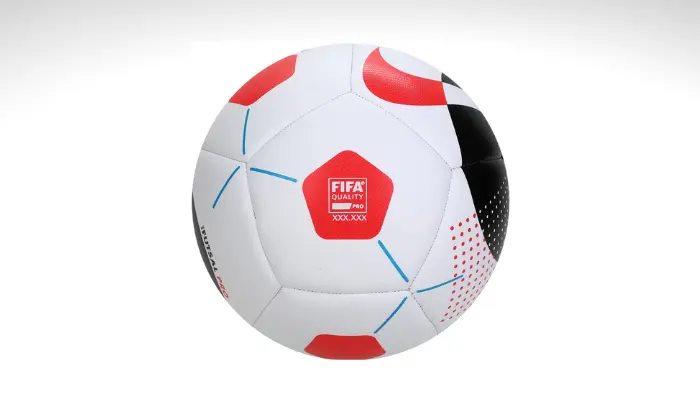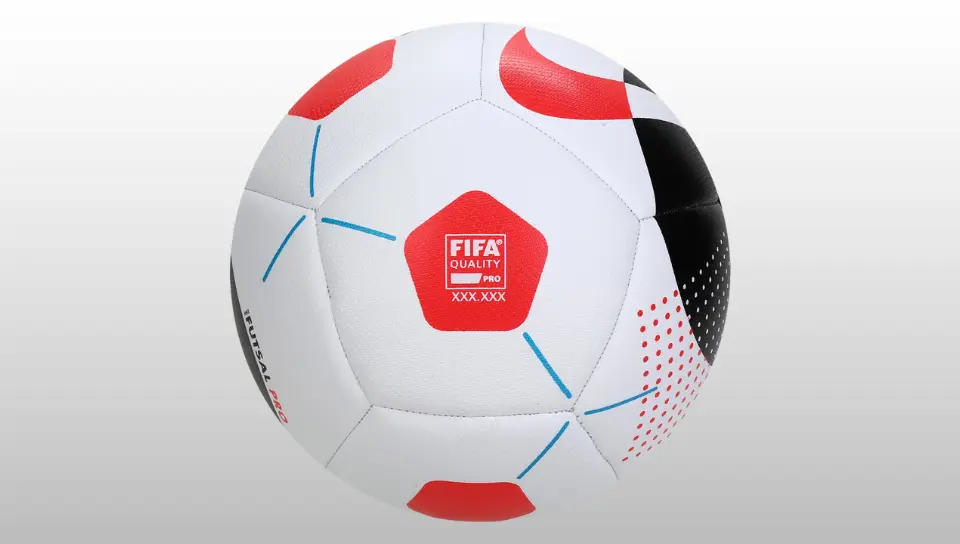Characteristics of the Futsal Ball
The futsal ball must be spherical and made of suitable material.
What is the circumference of the official Futsal ball?
A futsal ball should have a circumference between 62cm and 64cm.
What is the Weight of an Official Futsal Ball?
An official Futsal ball should weigh between 400g and 440g at the beginning of the game.
What is the pressure of an official Futsal ball?
An official Futsal ball should have a pressure equal to 0.6 to 0.9 atmospheres (600 to 900g/cm2) at sea level.
How to test the futsal ball?
To test whether a futsal ball is suitable for a match, proceed as follows:
- Hold the ball at a height of 2 meters from the ground;
- Drop the ball;
- The ball must not bounce below 50 cm or above 65 cm.
FIFA Approved Balls

All balls used in matches played in an official competition organized under the coordination of FIFA or confederations must meet the requirements and carry one of the FIFA Quality Program marks for balls.
Each mark indicates that the ball has been officially tested and meets the technical requirements specific to that mark, which are in addition to the stipulated minimum specifications and must be approved by FIFA.
Futsal Ball Advertising
Matches played in an official competition organized under the auspices of FIFA, confederations or national futsal associations, no form of commercial advertising is permitted on the ball, except for the competition logo/emblem, the competition organizer and the authorized manufacturer’s mark. Competition rules may restrict the size and number of such markings.
Additional Balls in Futsal
Additional balls that meet the requirements of the rule may be placed around the court. All balls are subject to the referees’ control.
Extra balls on the playing court
If an extra ball enters the playing court while the ball is in play, the referees must stop play only if the extra ball interferes with play.
Play must be restarted with a dropped ball in the position of the original ball when play was interrupted, unless this was inside the penalty area of the defending team and the last team to touch the original ball was the attacking team. In this case, the ground ball will occur on the line of the penalty area, at the point closest to where the original game ball was when the interruption occurred.
If an extra ball enters the playing court while the original ball is in play without interfering with the game, the referees allow play to continue and order the extra ball to be removed as soon as possible.
Replacing a defective ball in Futsal
If the Futsal ball becomes defective while in play, play is stopped and restarted with a “ground ball” with the replacement ball at the location where the original ball became defective.
The ball cannot be changed during the game without the permission of one of the referees.
Goal obtained with a defective ball
If the ball becomes defective after hitting one of the posts or the cross bar and enters directly into the goal, the referees must validate the goal.
Other Defective Ball Situations
If the ball is defective from a kick-off, a goal kick, a corner kick, a free kick, a free kick, a dropped ball, a penalty kick, a 10m shot, and before it touches any player or the goal, the kick is retaken.
More Futsal Content:
- Use of the Whistle in Futsal: When is it Obligatory?
- Futsal Referee Signals
- Penalty shootout in Futsal
- Simplifield Futsal Rules
- Blue Card in Futsal?
- Futsal Goalkeeper Rules
- Is allowed to slide tackle in Futsal?
- How Lonk is a Futsal Match
- How many players form a Futsal team
- Futsal Offensive Systems
- Futsal Rules
- Futsal Defensive System
